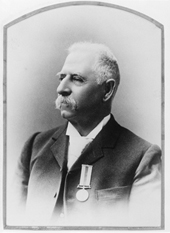
|
Administration - The Parliamentary Departments
 |
Five small parliamentary departments came into being with the Parliament. They were formalised by the commencement of section 14 of the Commonwealth Public Service Act on 1 January 1903.
The Department of the Senate and the House of Representatives provided administrative support to the houses, their members and their committees. In May 1901, there were 11 permanent officers on the staff of the Senate and 16 for the House of Representatives. The clerks of the houses were experts in parliamentary procedure and advised members and senators as well as compiling the official record of proceedings. |
Edwin Blackmore, Clerk of the Senate 1901-1908
National Library of Australia
As Clerk of the Senate, Blackmore was considered the most senior parliamentary officer and was called the Clerk of the Parliaments. He was a former Clerk of the Legislative Council of South Australia. |
 |
Many of the senior officers of the first Parliament were drawn from colonial parliaments. The first Clerk of the House of Represenatives, George Jenkins, was a former Clerk of the Legislative Council of Victoria. He returned to the Victorian Parliament and was replaced by Charles Gavan Duffy in July 1901. Duffy became Clerk of the Senate in 1917. |
Clerks of the House of Representatives, May, 1901
House of Representatives Library
Front row: W.A. Gale; Sir George Jenkins (Clerk); C.B. Boydell; T. Woollard.
Back row: H.A.R. Berry; E.T. Huber; F.L. Clapin; J.R. McGregor; E.W. Parkes. |
The Department of the Joint House Committee administered the parliamentary buildings and the provisions of refreshments.
The Parliamentary Library. In its first years, the Commonwealth Parliament shared the Library of the Victorian Parliament. The Victorian Parliamentary Librarian, Arthur Wadsworth, and his staff remained officers of the Victorian Parliament, and the Commonwealth reimbursed Victoria for their salaries. Victorian parliamentarians were justifiably proud of their library, and suggestions were made that the Commonwealth Parliament had chosen to sit at Victoria’s Parliament House in order to gain access to it.
 |
|
|
Library of the Victorian Parliament
Reproduced with the Permission of the Victorian Parliamentary Library |
|
Arthur Wadsworth, Librarian to the Commonwealth Parliament from June 1901
National Library of Australia |
|
The Parliamentary Reporting Service had a permanent staff of 11, headed by B.H. Friend. Commonwealth Parliamentary Debates (Hansard) was published first at weekly intervals. In the First Parliament, Hansard reporters were seated at the table of the Senate and the House of Representatives. |
Members of the Parliamentary Reporting Service, May 1901
Department of Parliamentary Services
B.H. Friend is in the centre of the front row |
 |
Press Gallery 1901, House of Representatives, Parliament House Victoria
National Library of Australia |
The Parliamentary Press Gallery.
Representatives of the press were authorised to report on the Parliament, at the discretion of the presiding officers. In the House of Representatives chamber, they were accommodated in galleries above and behind the Speaker. More than half of the 31 members of the Federal Parliamentary Press Gallery in 1901 represented Melbourne newspapers, but their reports were widely reproduced in the newspapers of other states.
|
 |
|


